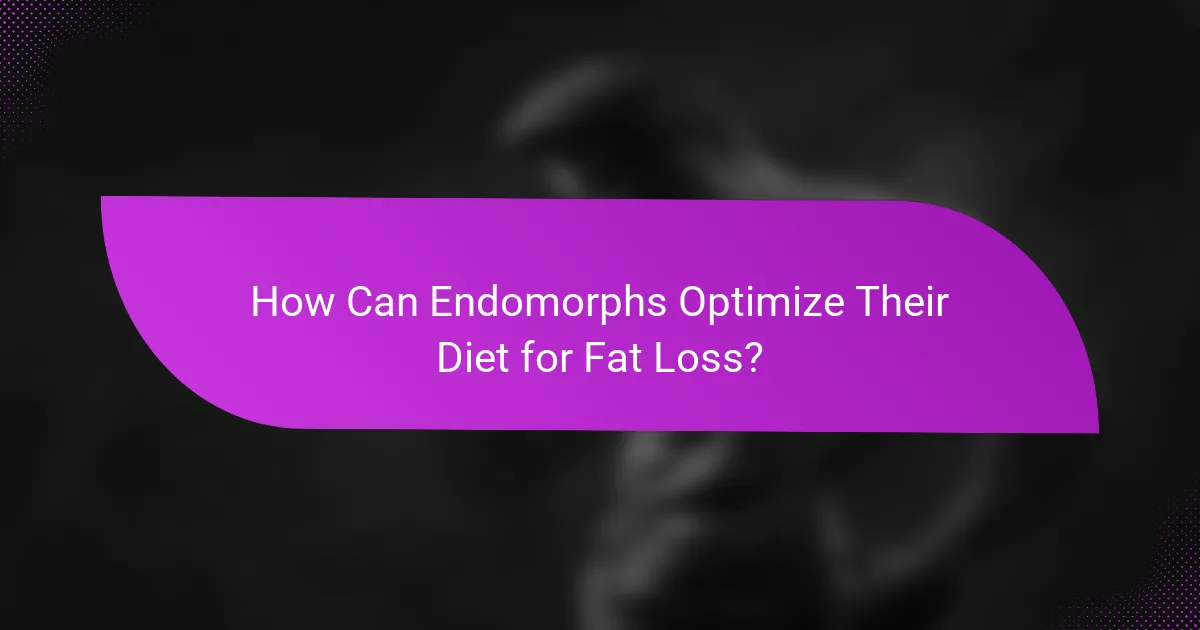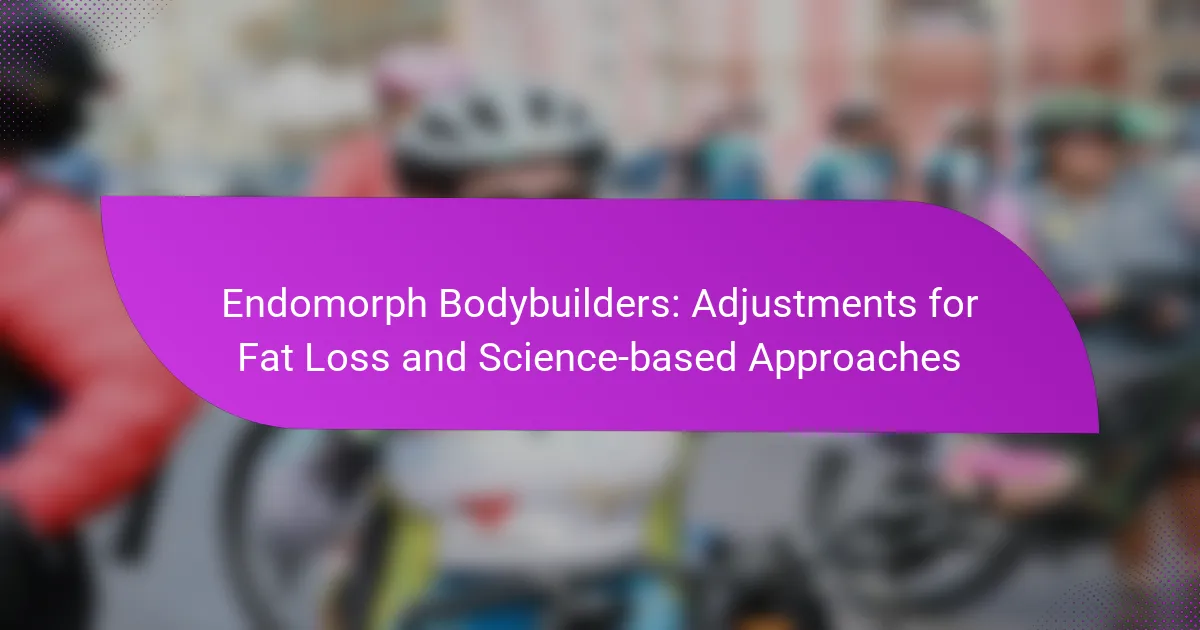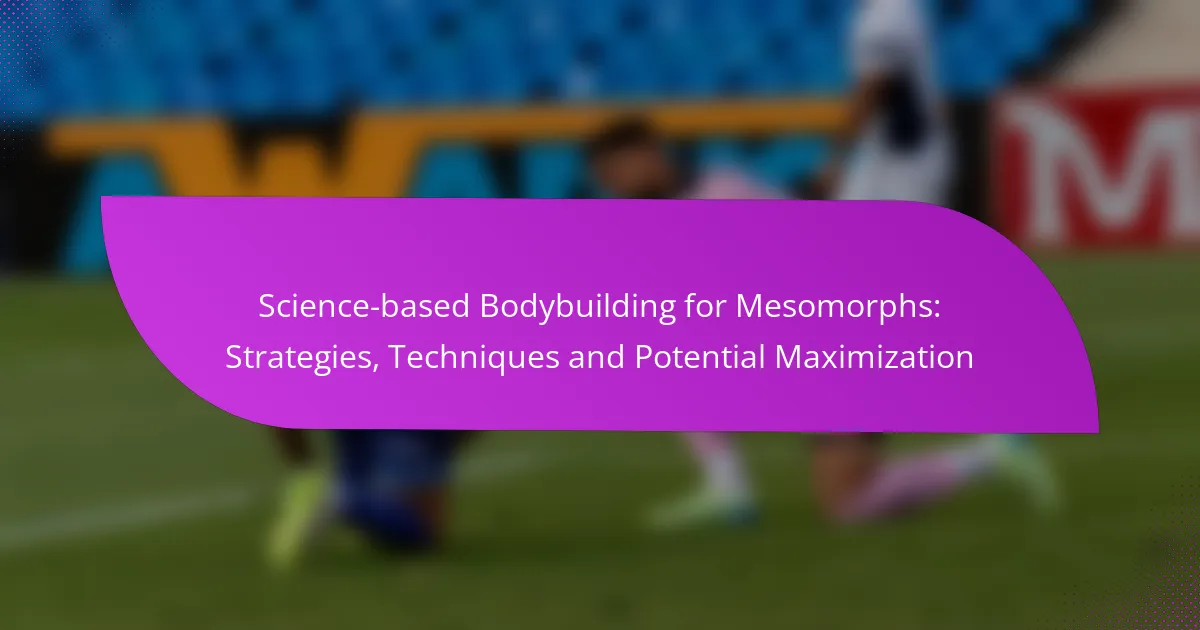Endomorph bodybuilders often face unique challenges when it comes to fat loss, requiring tailored strategies to achieve their goals. By creating a caloric deficit and making specific dietary adjustments, such as optimizing macronutrient ratios and increasing protein intake, they can effectively manage body composition. Incorporating cardio into their routines further aids in fat loss while preserving muscle mass, ultimately enhancing their physique and performance.

What Are Effective Fat Loss Strategies for Endomorph Bodybuilders?
Effective fat loss strategies for endomorph bodybuilders focus on creating a caloric deficit while incorporating specific training and dietary adjustments. These approaches help manage body composition and enhance muscle definition while minimizing fat gain.
Caloric Deficit
A caloric deficit is essential for fat loss, requiring endomorph bodybuilders to consume fewer calories than they expend. Aim for a deficit of around 500-750 calories per day to promote steady fat loss without sacrificing muscle mass. Tracking daily intake using apps can simplify this process.
Be cautious of extreme deficits, as they can lead to muscle loss and metabolic slowdown. A moderate approach ensures sustainable results and maintains energy levels for workouts.
High-Intensity Interval Training (HIIT)
HIIT is an effective fat-burning strategy that combines short bursts of intense exercise with rest or low-intensity periods. This method can boost metabolism and promote fat loss while preserving muscle mass, making it ideal for endomorphs. Sessions can last from 15 to 30 minutes, fitting well into busy schedules.
Incorporate HIIT workouts 2-3 times per week, using exercises like sprints, cycling, or bodyweight movements. This approach not only enhances cardiovascular fitness but also increases post-exercise calorie burn.
Strength Training Focus
Strength training is crucial for endomorph bodybuilders to build and maintain muscle while losing fat. Prioritize compound movements such as squats, deadlifts, and bench presses, which engage multiple muscle groups and promote greater calorie expenditure. Aim for 3-5 sessions per week.
Utilize progressive overload by gradually increasing weights or resistance to continue challenging your muscles. This strategy helps maintain muscle mass during a caloric deficit, ensuring a toned appearance as fat decreases.
Macro Nutrient Adjustments
Adjusting macronutrient ratios can significantly impact fat loss for endomorph bodybuilders. A common approach is to increase protein intake to around 25-30% of total calories, which supports muscle retention and satiety. Carbohydrates may be moderated, focusing on complex sources like whole grains and vegetables.
Healthy fats should also be included, making up about 20-30% of daily intake. This balance helps maintain energy levels and supports overall health while promoting fat loss.
Meal Timing Techniques
Meal timing can influence fat loss and energy levels for endomorph bodybuilders. Consider spreading meals into 4-6 smaller portions throughout the day to stabilize blood sugar and control hunger. This approach can prevent overeating and support consistent energy for workouts.
Additionally, consuming protein-rich meals or snacks post-workout can enhance recovery and muscle synthesis. Pay attention to your body’s hunger cues, adjusting meal timing as needed to optimize performance and fat loss.

How Can Endomorphs Optimize Their Diet for Fat Loss?
Endomorphs can optimize their diet for fat loss by focusing on macronutrient ratios that support their unique metabolic profiles. This involves implementing low-carb diets, increasing protein intake, and consuming more fiber to enhance satiety and regulate blood sugar levels.
Low-Carb Diets
Low-carb diets can be particularly effective for endomorphs, as they help reduce insulin levels and promote fat burning. A typical approach might involve limiting carbohydrate intake to around 50-150 grams per day, depending on individual needs and activity levels.
When adopting a low-carb diet, prioritize whole foods such as lean meats, eggs, nuts, and non-starchy vegetables. Avoid processed foods and sugars, which can lead to weight gain and hinder fat loss efforts.
High-Protein Intake
Increasing protein intake is crucial for endomorphs aiming for fat loss, as protein helps build and maintain muscle mass while promoting feelings of fullness. Aim for a protein intake of approximately 1.6-2.2 grams per kilogram of body weight per day.
Incorporate high-protein foods like chicken, fish, legumes, and dairy into meals and snacks. This not only supports muscle recovery but also boosts metabolism through the thermic effect of food, which is higher for protein compared to fats and carbohydrates.
Increased Fiber Consumption
Fiber plays a vital role in fat loss for endomorphs by enhancing digestion and promoting satiety. Aim for a daily fiber intake of around 25-35 grams, focusing on whole grains, fruits, vegetables, and legumes.
Including fiber-rich foods in your diet can help stabilize blood sugar levels and reduce cravings. Consider adding foods like oats, chia seeds, and leafy greens to meals to increase fiber content effectively.

What Role Does Cardio Play in Endomorph Bodybuilding?
Cardio plays a crucial role in endomorph bodybuilding by aiding fat loss while preserving muscle mass. For endomorphs, who typically have a higher propensity to store fat, incorporating cardio can enhance metabolic rate and improve overall body composition.
Types of Cardio for Fat Loss
There are two main types of cardio beneficial for fat loss: steady-state and high-intensity interval training (HIIT). Steady-state cardio, such as jogging or cycling at a consistent pace, helps build endurance and can be performed for longer durations. HIIT, on the other hand, involves short bursts of intense activity followed by rest or low-intensity periods, which can significantly boost calorie burn in a shorter time.
Both types have their advantages; steady-state cardio is easier to maintain over longer sessions, while HIIT can be more time-efficient and effective for fat loss. Endomorphs may find that a combination of both yields the best results.
Frequency and Duration Recommendations
For endomorph bodybuilders, a good starting point is to aim for cardio sessions 3 to 5 times per week. Each session can last anywhere from 20 to 45 minutes, depending on the intensity and type of cardio chosen. For example, steady-state sessions might be longer, while HIIT can be shorter but more intense.
It’s essential to monitor how your body responds to cardio. If you notice excessive fatigue or muscle loss, consider adjusting the frequency or duration. Balancing cardio with resistance training is crucial to ensure muscle preservation while promoting fat loss.

What Are the Best Supplements for Endomorph Bodybuilders?
Endomorph bodybuilders can benefit from specific supplements that support fat loss while preserving muscle mass. Key options include protein powders, fat burners, and creatine, each serving a unique purpose in a well-rounded fitness regimen.
Protein Powders
Protein powders are essential for endomorph bodybuilders to meet their protein needs without excessive calories. Whey protein is a popular choice due to its high biological value and quick absorption, making it ideal for post-workout recovery.
Consider using protein powders to supplement your diet, especially if you struggle to consume enough protein through whole foods. Aim for a daily intake of around 1.6 to 2.2 grams of protein per kilogram of body weight, adjusting based on your activity level and goals.
Fat Burners
Fat burners can aid endomorph bodybuilders in enhancing fat loss while preserving lean muscle. Ingredients like caffeine, green tea extract, and L-carnitine are commonly found in these supplements and may help increase metabolism and energy expenditure.
When choosing a fat burner, look for products with transparent labeling and clinically supported ingredients. Start with a lower dose to assess tolerance, and avoid relying solely on fat burners; they should complement a balanced diet and exercise routine.
Creatine
Creatine is a well-researched supplement that can enhance strength and muscle mass, making it beneficial for endomorph bodybuilders. It works by replenishing ATP stores in muscles, allowing for improved performance during high-intensity workouts.
To use creatine effectively, consider a loading phase of about 20 grams per day for 5-7 days, followed by a maintenance dose of 3-5 grams daily. Stay well-hydrated, as creatine can increase water retention in muscles, which is particularly relevant for endomorphs aiming to manage body composition.

How to Create a Workout Plan for Endomorphs?
Creating a workout plan for endomorphs involves focusing on strength training, cardio, and recovery to effectively manage body composition. Endomorphs typically have a higher propensity to store fat, so a balanced approach that emphasizes calorie expenditure and muscle maintenance is crucial.
Strength Training Schedule
A strength training schedule for endomorphs should prioritize compound movements that engage multiple muscle groups. Aim for 3-5 sessions per week, focusing on exercises like squats, deadlifts, bench presses, and rows. Each session can include 3-4 sets of 8-12 repetitions to promote muscle growth while keeping the metabolism elevated.
Incorporate progressive overload by gradually increasing weights or resistance to ensure continuous improvement. It’s beneficial to alternate between heavier lifting days and lighter, higher-rep days to balance intensity and volume.
Cardio Integration
Integrating cardio into the workout plan is essential for endomorphs to enhance fat loss. Aim for 150-300 minutes of moderate-intensity cardio each week, which can include activities like brisk walking, cycling, or swimming. High-intensity interval training (HIIT) can also be effective, offering shorter sessions that boost calorie burn.
Consider scheduling cardio sessions on non-strength training days or after weightlifting to maximize fat utilization. Monitor your heart rate to ensure you’re working within the optimal range for fat burning, typically around 60-75% of your maximum heart rate.
Recovery Strategies
Recovery is a vital component of any workout plan, especially for endomorphs who may experience fatigue more quickly. Ensure adequate rest between strength training sessions, allowing at least 48 hours for muscle groups to recover. Incorporate active recovery days with light activities such as yoga or stretching to promote blood flow and flexibility.
Prioritize sleep, aiming for 7-9 hours per night, as it plays a critical role in muscle recovery and hormonal balance. Additionally, consider nutrition strategies that support recovery, such as consuming protein-rich meals post-workout and staying hydrated throughout the day.



